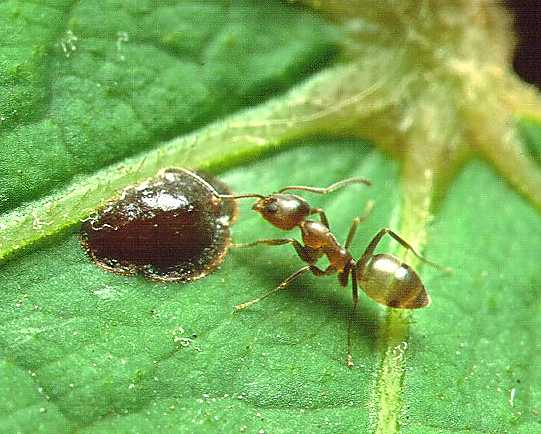When summer comes, the ants invade houses. Particularly bad are the Argentine ants, an invasive species which has spread all around the world. So what to do if your house gets swarmed? Spraying and laying commercial pesticides aren’t ideal because they are toxic and bad for the environment. A group at the University of California, Riverside led by post-doc Jia-Wei Tay are reinventing the way insecticides are delivered. The researchers created a hydrogel that has a very tiny, but effective dose of insecticide that targets ants, and biodegrades harmlessly. The hydrogel is made out of seaweed and inexpensive; it worked very well to reduce ant populations.
Insecticide sprays aren’t ideal because they can kill helpful insects and contaminate the environment. Here is where the hydrogels come in. They are essentially little gel balls made from seaweed that have the consistency of jello. They contain sugar water (to lure the ants) and 0.0001 percent of the insecticide thiamethoxam. Because the concentration of the insecticide is so low, it is less harmful to other creatures. The seaweed based hydrogel decomposes naturally and is non-toxic.
“This is 100-fold less than it is used in a standard ant gel bait and 1,000 times less concentrated than spray insecticides containing thiamethoxam,” lead author Tay said.

Once an ant finds one of the hydrogel balls, it drinks from the hydrogel and takes some of the liquid back to the nest where it is shared with other ants. The ant also creates a trail to the hydrogels that other ants will follow. The poison works slowly so that it can be spread between tens of thousands of ants in the span of a few days.
After 4 four weeks, the hydrogels reduced ant populations by 40 to 68 percent. Another treatment for a subsequent two weeks reduced the ant’s populations by 61 to 79 percent. It is important that the hydrogels stay moist so that the ants are attracted to it. These hydrogels lose most of their water after the first 8 hours. The researchers are now looking to extend it for commercial use. For now, the hydrogels still worked because most (66%) of ants visited them within 4 hours after they were placed. Perhaps in the future ant pheromones could be incorporated into the hydrogel to make the search time even shorter.
Researchers are now looking to extend it for commercial use. For now, the hydrogels still worked because most (66%) of ants visited them within 4 hours after they were placed. Perhaps in the future ant pheromones could be incorporated into the hydrogel to make the search time even shorter.
“A 70 percent reduction is really successful, especially considering we are not spraying an insecticide but instead using a very targeted method that is better for the environment. With 70 percent control, homeowners really don’t see any ants,” said Dong-Hwan Choe, an assistant professor of entomology at UC Riverside.

The hydrogels could be used in houses and also in orchards, where Argentine ants are a real problem. The Asian citrus psyllid, a sap-sucking bug, severely damages citrus trees by spreading bacterial diseases. In California, predator wasps were released to kill the psyllid. However, the Argentine ants kill the wasps. Argentine ants also protect other pests from their natural enemies. Thye hydrogels could be very helpful to non-toxically protect citrus production. By removing the ants, natural predators can do their job getting rid of pests without interference. You could add in other insecticides or other target other organisms, the hydrogel system is not just limited to ants. The system is very versatile, you can change a lot.
Journal reference: Tay, J. et al., 2017. “Development of an alginate hydrogel to deliver aqueous bait for pest ant management.” Pest Management Science.






